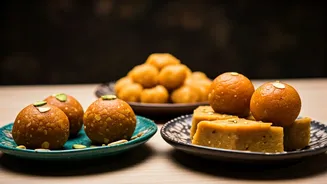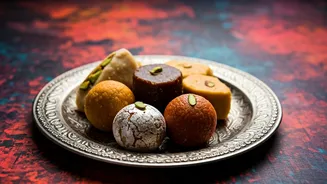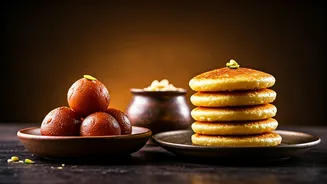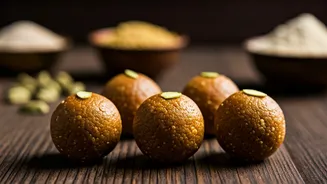The Essence of Diwali
Diwali, the festival that illuminates the hearts of millions, is a time for jubilation, togetherness, and, most importantly, delectable sweets. Traditional
Diwali treats often involve rich ingredients that are high in sugar and fats. However, this doesn't mean you have to forgo the pleasure of enjoying these sweets altogether. By incorporating healthier alternatives and simple cooking techniques, it's entirely possible to create festive sweets that are both delicious and good for you. These recipes are designed to help you celebrate Diwali with enthusiasm while making mindful choices about your diet. The emphasis is on creating delightful sweets that maintain your health without reducing the enjoyment of the festival.
Baked Anjeer Rolls
Anjeer rolls, or fig rolls, offer a naturally sweet and fiber-rich treat, perfect for those looking for a lighter alternative to traditional sweets. Start by soaking dried figs in warm water to soften them. Then, blend the figs with a small amount of chopped nuts such as almonds and cashews until you have a smooth paste. Add a touch of cardamom powder for flavor. Roll out the mixture into small logs, wrap them in a parchment paper, and refrigerate for a few hours to set. For added texture, you can gently roll the logs in chopped nuts before refrigerating. Baking the rolls provides a delightful warmth. This recipe not only reduces added sugars but also incorporates ingredients rich in antioxidants and beneficial fats, making your Diwali treat both flavorful and healthful. This approach allows you to savor a classic taste while promoting a healthier approach to festive eating.
Oats and Dates Ladoo
Ladoos are a festive favorite, and this recipe transforms them into a nutritious and guilt-free delight. Begin by dry roasting oats until they turn golden brown and fragrant. In a separate pan, roast dates to caramelize their natural sugars. Once cooled, blend the dates and oats into a coarse mixture. Add a handful of nuts and seeds, such as pumpkin or sunflower seeds for extra crunch and nutrition. Shape the mixture into small ladoos. The advantage of this recipe lies in using oats as a base, which are rich in fiber and provide sustained energy. The dates serve as a natural sweetener, adding a rich flavor without refined sugar. These ladoos offer a perfect combination of taste and wellness, making them an excellent choice for a festive treat.
Moong Dal Halwa
This is a twist on the traditional moong dal halwa, focusing on a healthier cooking approach. Start by soaking moong dal for a few hours, and then grind it into a fine paste. In a non-stick pan, sauté the paste with a small amount of ghee or clarified butter until it starts to brown, ensuring continuous stirring to prevent sticking. Add a sweetener such as jaggery, which provides sweetness without refined sugar. Add water and stir until the mixture thickens. Garnish with chopped nuts and saffron strands for an inviting look and improved taste. The use of a non-stick pan cuts down the need for excessive amounts of ghee, and jaggery adds a natural, healthier sweetness. This method enhances the nutritional value, making it a healthier version of the cherished traditional dessert.
Ragi Laddus
Ragi, or finger millet, is a powerhouse of nutrients, making it an excellent choice for a healthy dessert. The recipe involves roasting ragi flour until a pleasant aroma fills your kitchen. Combine the roasted ragi with roasted nuts and seeds, and then add a sweetener like dates or jaggery. Mix everything thoroughly and bind the mixture to form small laddus. Ragi is rich in fiber and essential minerals, making these laddus both nourishing and delicious. This recipe provides a balanced treat, allowing you to indulge in the festive sweetness without sacrificing your commitment to well-being. These laddus also offer a welcome textural contrast, which enhances the overall sensory experience.




